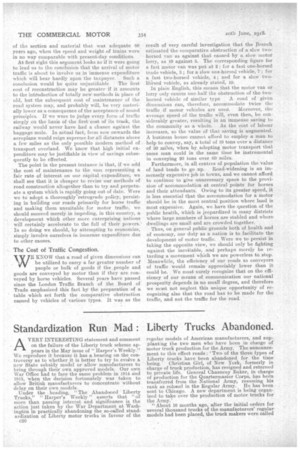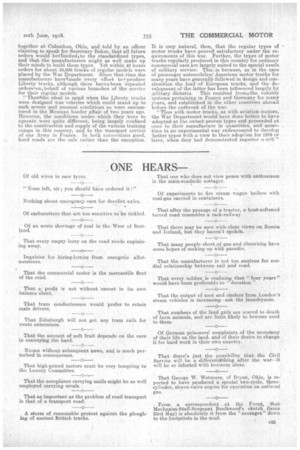Standardization Run Mad : Liberty Trucks Abandoned.
Page 2

Page 3

If you've noticed an error in this article please click here to report it so we can fix it.
AVERY INTERESTING statement and comment on the failure of the Liberty truck scheme appears in the May issue of " Harper's Weekly." We reproduce it because it has a bearing onthe controversy as to whether it is better to try to evolve a new State subsidy model or allow manufacturers to bring through their own approved models. Our own War Office had to face the same problem in 1914 and 1915, when the decision fortunately was taken to allow British manufacturers to concentrate without delay on their own models.
Under the heading, "The Abandoned Liberty Trucks," " Harper's Weekly " -asserts that "of more than passing interest and significance. is the action just taken by the War Department at Washington in practically Abandoning the so-called standardization of Liberty motor trucks in favour of the e20 .
regular models of American manufacturers, and supplanting the two men who have been in charge of motor truck production for the Army. The announcement to this effect reads : 'Two of the three types of Liberty trucks have been abandoned for the time being. Christian Girl, of New York, formerly in charge of truck production,, has resigned and returned to private life. General Chauncey Baker, in charge of production for the Quartermaster Corps, has been transferred from the National Army, resuming his rank as colonel in the Regular Army. He has been sent to Chicago. A new department is being organized to take over the production of motor trucks for the Army.'
"About 10 months ago, after the initial orders for several thousand trucks of the manufacturers' regular models had been placed, the truck makers were called
together at Columbus, Ohio, and told by an officer claiming to speak for Secretary-Ba.ker; that all future orders would bellimitedito the standardized types, and that the manufacturers might as well make up their minds to build these types. Yet within 43 hours orders for about 10,000 trucks of regular models were placed by the War Department. Since that time the manufacturers havOimade every effort to ..:.produce Liberty trucks, although there have0:men repeated orders torqbehalf. of various branches of the service for their regular, models. • .‘" Thusithe ideal in mind when the Liberty trucks were designed was vehicles which could stand up to such severe and unusual conditions as were encountered in the Mexican border affair of two years ago. However, the conditions under which they were to operate were quite different, being largely confined to the construction and supply of the various training camps in this country; and to the transport service of our Army in France. In both connections good, hard roads are the rule rather than the exception. It is only natural, then, that the regular types of motor trucks have proved satisfactory under the requirements of this war. Further, the types of motor trucks regularly produced in this country for ordinary commercial uses are largely suited to the special Deeds of military service: This,is because, as in the case of passenger automobilesf American motor truCks for many years have generally followed in design and construetion the leadof European trucks, and the development of the latter has been influenced largely by :nilitary dictates. This resulted fromthe subsidy systems pertaining in France and Germany for many years, and established in the other countries abroad before the outbreak of the war.
"Thus with motor trucks, as with aviation motors, the War Department would have done better to have adoptecLat the outset proven types arid proceeded at once to their manufacture in quantities, and meantime in an experimental way endeavoured to develop better types with a view to their adoption for 1919 or later, when they had demonstrated superior IT erit."






















